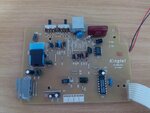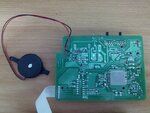EricaS
Member level 3

Hello
Is it possible for a pizeobuzzer ringer to emit audio as RF?
Here are some pics of the buzzer. (Black object).


Someone once had this to say:
"I have no direct experience but a change in the position of the diaphragm will certainly change the impedance of the coil which will affect both its Q and resonant frequency. A nearby transmitter may well have a detectable audio modulation of its frequency or power. That is after all how a metal detector works!"
Is it possible for a pizeobuzzer ringer to emit audio as RF?
Here are some pics of the buzzer. (Black object).


Someone once had this to say:
"I have no direct experience but a change in the position of the diaphragm will certainly change the impedance of the coil which will affect both its Q and resonant frequency. A nearby transmitter may well have a detectable audio modulation of its frequency or power. That is after all how a metal detector works!"
Last edited by a moderator:


